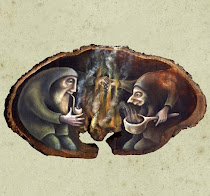Monday, 21 October 2013
The Baba Yaga Book
Written by
Rima Staines
at
1:55 pm
11
words from others
![]()
Tags: baba yaga, books, fairy tales, illustration, russian folklore, russian folktale, slavic mythology, the baba yaga book, witch
Sunday, 26 May 2013
A Forest of Pencils
 |
| Rima Staines - In The Leshy Forest - Tiny Pencil Issue 1 - Forests |
 | |
|
 |
| Tiny Pencil Issue 1 - Forests - artwork by Stuart Whitton |
 |
| Tiny Pencil Issue 1 - Forests - artwork by Rachel M Bray |
 |
| Tiny Pencil Issue 1 - Forests - artwork by Yoko Tanaka |
 |
| Tiny Pencil Issue 1 - Forests - artwork by Vanessa Foley |
 |
| Tiny Pencil Issue 1 - Forests - artwork by Alexandra Higlett |
 |
| Tiny Pencil Issue 1 - Forests - artwork by Lisa Evans |
 |
| Tiny Pencil Issue 1 - Forests - artwork by Raymond Lemstra |
 |
| Tiny Pencil Issue 1 - Forests - artwork by Caitlin Hackett |
 |
| Tiny Pencil Issue 1 - Forests - artwork by Sigrid Rødli |
Written by
Rima Staines
at
9:56 am
21
words from others
![]()
Tags: drawing, forest, graphite, illustration, leshy, magazines, pencil, russian folklore, slavic mythology, tiny pencil, wilderness, woods, Леший
Wednesday, 17 November 2010
Ventriloquism














Written by
Rima Staines
at
12:22 pm
60
words from others
![]()
Tags: book cover, catherynne m valente, fairy tales, lullaby, russian folklore, stories, surrealism, ventriloquism, watercolour
Thursday, 3 January 2008
Snegurochka
 SNEGUROCHKA, the Russian Snow Maiden is the daughter of Father Frost and Mother Spring. The legend tells that she became more beautiful with each day she grew, and her parents realised that she was becoming a young woman who they could not keep secluded from the world for ever.
SNEGUROCHKA, the Russian Snow Maiden is the daughter of Father Frost and Mother Spring. The legend tells that she became more beautiful with each day she grew, and her parents realised that she was becoming a young woman who they could not keep secluded from the world for ever.
Snegurochka is allowed to explore the world and comes to meet new people and young men who fall in love with her. However, as long as she remains in the forest, its spirit protects her from Yarilo, the sun god, and her suitors cannot find her. Eventually, Mother Spring gives her a Love Wreath made from flowers, knowing with both sadness and delight that it would warm up her cold heart. Snegurochka is then able to fall in love and spends one happy evening with her sweetheart, singing and dancing. But she knows that with the first rays of the sun god in the morning she will melt away and be gone.
Illustration: drypoint etching
Written by
Rima Staines
at
10:16 am
3
words from others
![]()
Tags: russian folklore, seasons, snegurochka, snow maiden, winter
Wednesday, 2 January 2008
Father Frost
 FATHER FROST or Dedt Moroz is a Siberian ice spirit who hides in fir trees deep in the forest and as he snaps his fingers, he splits and shatters the trees.
FATHER FROST or Dedt Moroz is a Siberian ice spirit who hides in fir trees deep in the forest and as he snaps his fingers, he splits and shatters the trees.
Legend tells a similar story to that of Mother Holle, involving a Husband and his second wife, each with a daughter from their first marriages. The wife’s daughter was spoiled and mean, whereas the husband’s daughter was very gentle and kind. The wife only loved her daughter and made the other girl work very hard. The poor girl cleaned and cooked for her stepmother, and was often beaten as the wife’s hatred for her grew.
One day, in the middle of a terrible winter, the wife decided that the girl should be taken deep into the woods and left there to die. The husband of course did not want to agree to this, but himself also afraid of the woman, he reluctantly took his daughter into the forest where he left her. The girl sat helpless and alone under a tree. Soon she heard the breaking and snapping of twigs and branches, and then a voice spoke. “Are you warm my child?” It asked. The girl recognized the ominous voice as that of Father Frost and replied, “Yes Father Frost, I'm quite warm.” Father Frost repeated his question several times, each time coming closer to the girl. The girl always answered that she was warm, and then thanked him. Feeling pity for the poor creature, Father Frost wrapped her in a beautiful coat, showered her with gifts, and kept her warm throughout the night.
Returning the next day to retrieve his daughter's body, the husband was happily surprised to find her not only alive, but dressed warmly and covered with riches. Upon their return home, the jealous wife then insisted that her own daughter be left in the forest overnight, hoping that she too would return wealthy.
Again the husband travelled deep into the woods, this time leaving his step daughter there. As the night grew long she too heard the voice of Father Frost. “Are you warm my child?” he asked. The girl was annoyed with his question and replied, “Of course not, now leave me alone!” Father Frost was enraged with her reply and sent the coldest frost that there had ever been.
When the husband went into the woods the next day, he returned not with the girl showered in riches, but with her cold frozen body instead. Upon his return home he took his daughter and left his evil wife. The husband and his daughter lived happily ever after.
Illustration: drypoint etching
Written by
Rima Staines
at
6:13 pm
2
words from others
![]()
Tags: dedt moroz, father frost, russian folklore, siberia, winter




























































